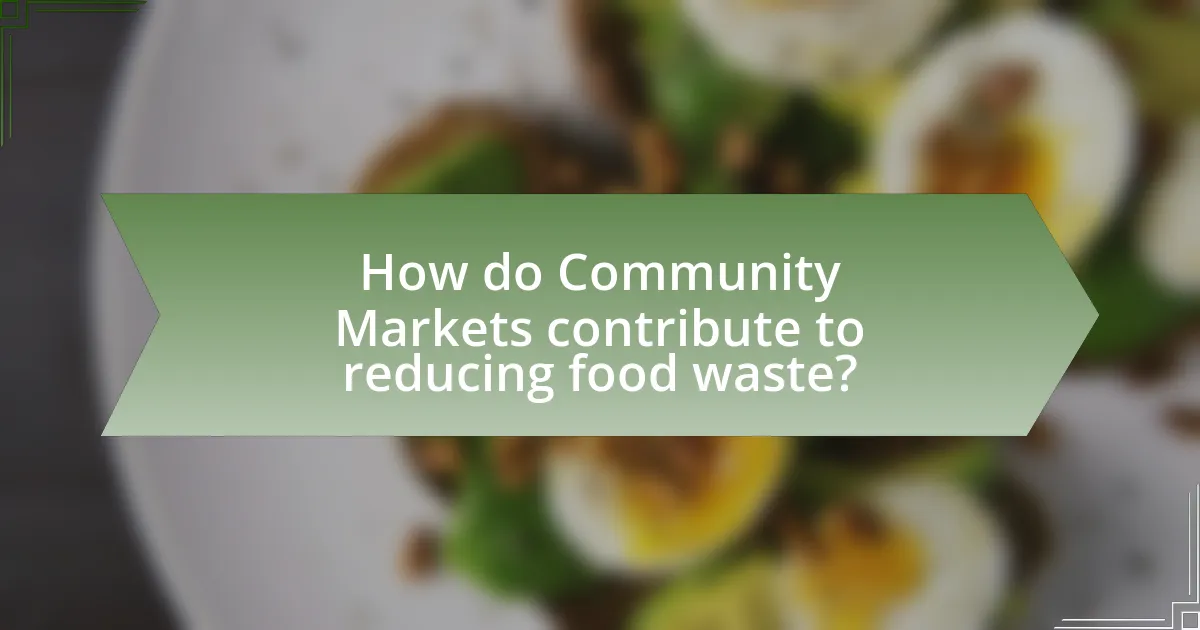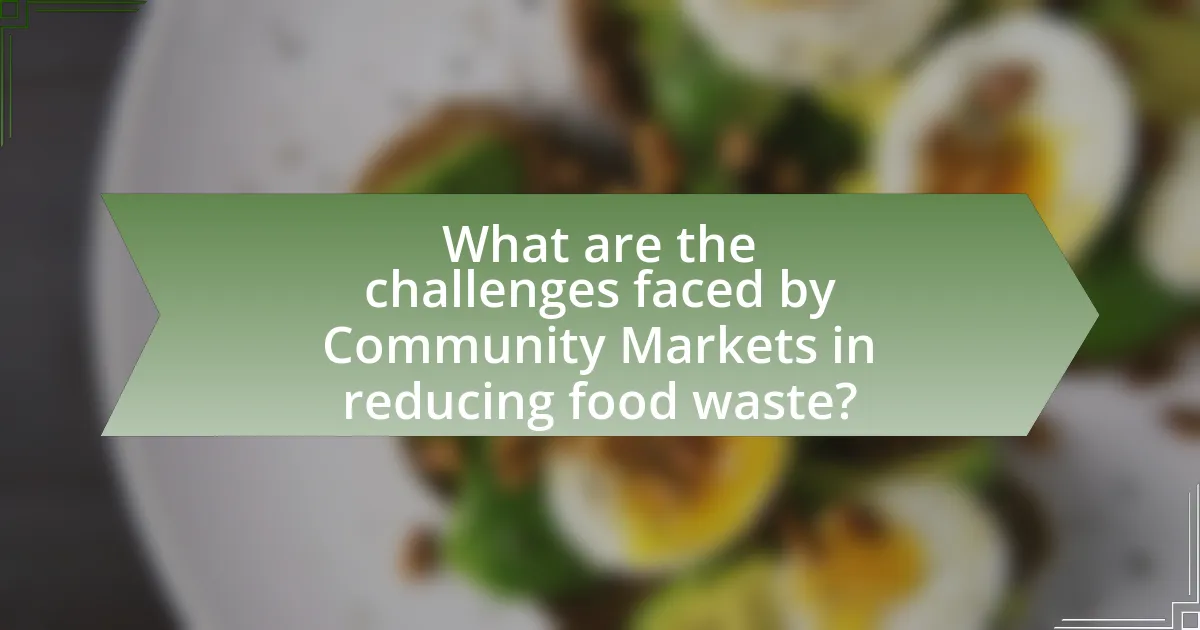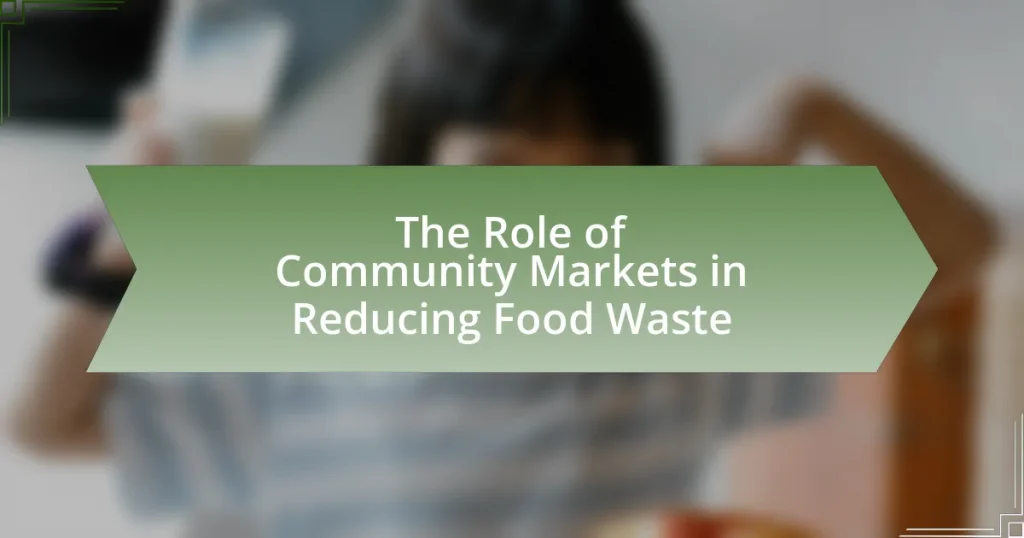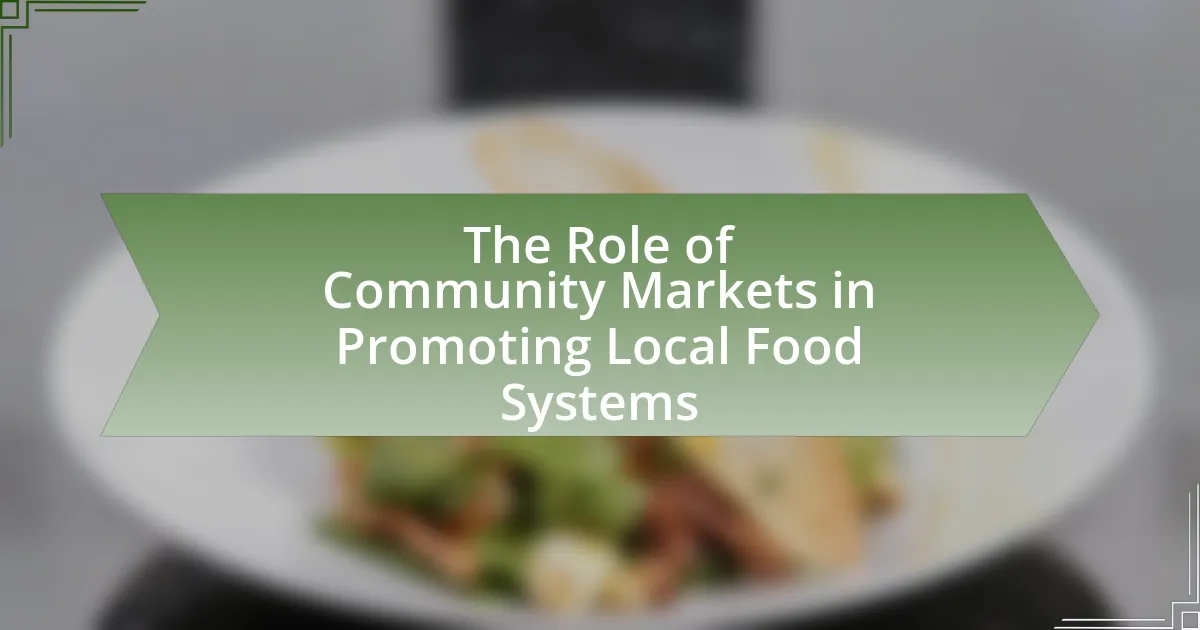Community markets serve as local platforms where producers and consumers interact directly to buy and sell goods, primarily focusing on food items. These markets play a crucial role in reducing food waste by facilitating the sale of surplus or imperfect produce that might otherwise be discarded, with research indicating they can decrease food waste by up to 30%. They support local economies by providing farmers with direct access to consumers, enhancing food accessibility in underserved areas, and promoting sustainable practices. Additionally, community markets educate consumers about food waste reduction strategies and foster community engagement, ultimately contributing to a more resilient and sustainable food system.

What are Community Markets and Their Purpose?
Community markets are local platforms where producers and consumers engage directly to buy and sell goods, primarily food items. Their purpose is to foster community connections, support local economies, and reduce food waste by facilitating the sale of surplus or unsold products that might otherwise be discarded. Research indicates that community markets can significantly decrease food waste; for instance, a study by the Food and Agriculture Organization highlights that local markets can reduce food loss by up to 30% through direct sales of excess produce.
How do Community Markets operate in local economies?
Community markets operate in local economies by providing a platform for local producers to sell their goods directly to consumers, thereby fostering economic resilience and sustainability. These markets facilitate the exchange of fresh, locally sourced food, which reduces transportation costs and carbon emissions associated with food distribution. Additionally, community markets often prioritize surplus or imperfect produce that would otherwise go to waste, directly addressing food waste issues. According to a study by the USDA, farmers’ markets contribute to local economies by generating approximately $1 billion in sales annually, highlighting their significant role in supporting local agriculture and reducing food waste.
What types of products are typically sold in Community Markets?
Community markets typically sell fresh produce, baked goods, dairy products, meats, and artisanal items. These markets often feature locally sourced fruits and vegetables, which help reduce food waste by promoting the sale of surplus or imperfect items that might not meet retail standards. Additionally, community markets may offer prepared foods and handmade crafts, further supporting local economies and minimizing waste through the sale of goods that might otherwise go unsold.
How do Community Markets differ from traditional grocery stores?
Community markets differ from traditional grocery stores primarily in their focus on local sourcing and community engagement. Community markets typically prioritize selling locally produced goods, which reduces transportation emissions and supports local economies, while traditional grocery stores often rely on a broader supply chain that includes national and international products. Additionally, community markets frequently emphasize sustainability practices, such as reducing food waste through initiatives like selling imperfect produce or offering discounts on items nearing expiration, contrasting with traditional grocery stores that may discard unsold items. This local and sustainable approach not only fosters community relationships but also contributes to a reduction in overall food waste, as evidenced by studies showing that local sourcing can decrease waste by up to 30% compared to conventional grocery models.
Why are Community Markets important for food distribution?
Community markets are important for food distribution because they facilitate direct access to fresh, locally sourced produce, thereby reducing food waste. By connecting local farmers with consumers, community markets help ensure that surplus food is sold rather than discarded, addressing both food insecurity and environmental concerns. Research indicates that community markets can decrease food waste by up to 30% by promoting the sale of imperfect or surplus items that would otherwise go unsold in traditional retail settings. This direct-to-consumer model not only supports local economies but also fosters sustainable practices in food distribution.
How do Community Markets support local farmers and producers?
Community markets support local farmers and producers by providing them with direct access to consumers, which enhances their sales opportunities and reduces reliance on intermediaries. This direct-to-consumer model allows farmers to retain a larger portion of the profits from their products, fostering economic sustainability. Additionally, community markets often prioritize local and seasonal produce, which encourages farmers to grow diverse crops and reduces food waste by promoting the sale of items that might otherwise go unsold. Research indicates that farmers participating in community markets can experience a 30% increase in income compared to traditional sales channels, demonstrating the financial benefits of this model.
What role do Community Markets play in enhancing food accessibility?
Community Markets significantly enhance food accessibility by providing local, affordable, and fresh produce directly to underserved communities. These markets often operate in areas with limited access to traditional grocery stores, thereby reducing food deserts. Research indicates that Community Markets can increase fruit and vegetable consumption by up to 30% among local residents, as they offer a diverse range of healthy options at lower prices compared to conventional retail outlets. Additionally, they often accept various forms of payment, including food assistance programs, further improving access for low-income families.

How do Community Markets contribute to reducing food waste?
Community markets contribute to reducing food waste by facilitating the sale of surplus food directly from producers to consumers, thereby minimizing the amount of unsold goods that would otherwise be discarded. These markets often source products that are deemed “imperfect” or close to expiration, which helps to divert food from landfills. For instance, a study by the Food Waste Reduction Alliance found that community markets can reduce food waste by up to 30% by promoting the sale of items that would typically be wasted. Additionally, they foster community awareness about food waste issues, encouraging consumers to make more sustainable choices.
What strategies do Community Markets employ to minimize food waste?
Community Markets employ several strategies to minimize food waste, including sourcing surplus food from local producers, implementing dynamic pricing models, and promoting consumer education on food preservation. By sourcing surplus food, these markets reduce the amount of edible food that would otherwise go to waste, as evidenced by a study from the Food Waste Reduction Alliance, which found that local sourcing can decrease food waste by up to 30%. Dynamic pricing models encourage consumers to purchase items that are nearing their expiration dates at reduced prices, effectively moving products before they spoil. Additionally, Community Markets often provide educational resources and workshops to teach consumers about food storage and preservation techniques, which can significantly extend the shelf life of perishable items.
How does the sale of imperfect produce impact food waste reduction?
The sale of imperfect produce significantly impacts food waste reduction by diverting edible food that would otherwise be discarded. Research indicates that approximately 20-40% of fruits and vegetables are rejected by retailers due to aesthetic standards, leading to substantial waste. By promoting the sale of these imperfect items, community markets can reduce this waste, as they provide consumers with affordable options while encouraging the consumption of produce that is still nutritious and safe to eat. This practice not only minimizes the environmental burden associated with food waste but also raises awareness about food sustainability among consumers.
What partnerships do Community Markets form to address food waste?
Community Markets form partnerships with local farms, food banks, and nonprofit organizations to address food waste. These collaborations enable Community Markets to source surplus food that would otherwise go to waste, redistribute it to those in need, and promote sustainable practices. For instance, partnerships with local farms allow Community Markets to acquire excess produce, while collaborations with food banks facilitate the distribution of food to underserved communities, effectively reducing food waste and enhancing food security.
How do Community Markets educate consumers about food waste?
Community markets educate consumers about food waste through workshops, informational signage, and community engagement initiatives. These markets often host events that teach consumers about the impact of food waste on the environment and economy, providing practical tips on reducing waste at home. For instance, studies show that community-based programs can lead to a 20-30% reduction in food waste among participants by increasing awareness and changing consumer behavior. Additionally, community markets may collaborate with local organizations to distribute educational materials that highlight the importance of purchasing imperfect produce, which helps to reduce overall food waste.
What programs or workshops are offered to raise awareness?
Community markets often offer programs and workshops aimed at raising awareness about food waste reduction. These initiatives typically include educational sessions on sustainable food practices, cooking demonstrations using surplus ingredients, and community discussions focused on the importance of reducing food waste. For example, workshops may teach participants how to properly store food to extend its shelf life or how to creatively use leftovers. Such programs are designed to engage the community, promote sustainable habits, and provide practical solutions to minimize food waste.
How can consumers change their purchasing habits through Community Markets?
Consumers can change their purchasing habits through Community Markets by prioritizing local, seasonal produce and reducing reliance on mass-produced goods. Community Markets often feature fresh, locally sourced items, which encourages consumers to buy what is available rather than what is pre-packaged or imported. This shift not only supports local farmers but also minimizes food waste, as consumers are more likely to purchase items that are in season and have a shorter supply chain. Research indicates that buying local can reduce food waste by up to 30% due to fresher products having a longer shelf life and less spoilage. By engaging with Community Markets, consumers can develop a habit of making more sustainable choices that directly contribute to reducing food waste.

What are the challenges faced by Community Markets in reducing food waste?
Community Markets face several challenges in reducing food waste, primarily including limited resources, logistical issues, and consumer behavior. Limited resources hinder the ability to implement effective waste reduction programs, as many Community Markets operate on tight budgets and rely heavily on volunteers. Logistical issues arise from the complexities of managing perishable goods, including transportation and storage, which can lead to spoilage before products reach consumers. Additionally, consumer behavior poses a challenge, as some customers may prioritize aesthetics over freshness, leading to the rejection of perfectly edible food items that do not meet visual standards. These factors collectively impede the efforts of Community Markets to effectively minimize food waste.
What logistical issues do Community Markets encounter?
Community Markets encounter several logistical issues, including supply chain management, transportation challenges, and inventory control. These markets often struggle to coordinate with local farmers and suppliers to ensure a consistent flow of fresh produce, which can lead to shortages or surpluses. Transportation issues arise from the need to deliver goods efficiently while minimizing costs, particularly in rural areas where access may be limited. Additionally, inventory control is critical, as Community Markets must balance the perishability of food items with consumer demand to reduce waste effectively. These logistical challenges directly impact their ability to operate efficiently and fulfill their role in reducing food waste.
How do seasonal variations affect food availability and waste?
Seasonal variations significantly impact food availability and waste by influencing crop yields and consumer purchasing patterns. During peak harvest seasons, food availability increases, leading to lower prices and higher consumption; however, this can also result in surplus food that may go to waste if not sold or preserved. Conversely, during off-seasons, food scarcity can occur, driving up prices and potentially leading to increased waste as consumers may discard items that are past their prime due to limited availability. For instance, the USDA reports that approximately 30-40% of the food supply in the United States is wasted, with seasonal fluctuations contributing to this issue as excess produce during harvest times often exceeds demand.
What are the financial constraints that impact Community Markets?
Financial constraints that impact Community Markets include limited access to funding, high operational costs, and fluctuating market prices. Limited access to funding restricts the ability of these markets to invest in infrastructure and resources necessary for efficient operations. High operational costs, such as rent, utilities, and labor, can diminish profit margins, making it challenging to sustain the market. Additionally, fluctuating market prices for goods can lead to unpredictability in revenue, further complicating financial stability. These factors collectively hinder the effectiveness of Community Markets in their role of reducing food waste.
How can Community Markets overcome these challenges?
Community markets can overcome challenges by implementing strategies such as establishing partnerships with local farmers and food producers to ensure a steady supply of fresh, surplus food. These partnerships can reduce food waste by redirecting excess produce that would otherwise go unsold. Additionally, community markets can enhance consumer education about food preservation and waste reduction techniques, which can lead to more informed purchasing decisions and less waste at the consumer level. Research indicates that community-based initiatives can effectively reduce food waste by up to 30% when they engage local stakeholders and promote sustainable practices.
What innovative solutions are being implemented to reduce waste?
Innovative solutions being implemented to reduce waste include the establishment of community markets that facilitate the sale of surplus food from local producers. These markets not only provide a platform for farmers to sell excess produce but also help in redistributing food that would otherwise go to waste. For instance, studies have shown that community markets can reduce food waste by up to 30% by connecting consumers directly with local growers, thereby minimizing the supply chain inefficiencies that often lead to waste. Additionally, initiatives like food recovery networks and apps that connect businesses with food banks further enhance waste reduction efforts by ensuring that surplus food is redirected to those in need.
How can community involvement enhance the effectiveness of Community Markets?
Community involvement enhances the effectiveness of Community Markets by fostering local engagement and trust, which leads to increased participation and support. When community members actively participate in the planning and operation of these markets, they contribute valuable insights into local needs and preferences, ensuring that the offerings align with consumer demand. Research indicates that markets with strong community ties experience higher foot traffic and sales, as seen in the 2019 study by the American Journal of Agricultural Economics, which found that community-supported agriculture initiatives significantly reduced food waste by 30% through better matching of supply and demand. This collaborative approach not only boosts market viability but also strengthens community bonds, creating a sustainable ecosystem that effectively addresses food waste issues.
What practical steps can individuals take to support Community Markets in reducing food waste?
Individuals can support Community Markets in reducing food waste by actively participating in local food-sharing initiatives and purchasing imperfect or surplus produce. Engaging in food-sharing programs allows individuals to redistribute excess food that might otherwise go to waste, while buying imperfect produce helps reduce the stigma around food aesthetics and encourages markets to sell items that are still perfectly edible. According to a study by the Food Waste Reduction Alliance, approximately 30-40% of the food supply in the U.S. is wasted, highlighting the importance of community involvement in mitigating this issue. By choosing to buy from Community Markets, individuals not only support local economies but also contribute to a significant reduction in food waste.
How can consumers actively participate in Community Markets?
Consumers can actively participate in Community Markets by purchasing locally sourced products, engaging in volunteer activities, and providing feedback to market organizers. By buying food directly from local farmers and producers, consumers support sustainable practices that reduce food waste, as these markets often sell surplus or imperfect produce that would otherwise go unsold. Additionally, volunteering at these markets helps with operations and fosters community connections, while feedback can lead to improvements in market offerings and practices. Studies show that community engagement in local food systems can significantly decrease food waste, as evidenced by initiatives in various cities that have successfully reduced waste through consumer involvement.
What are the best practices for reducing food waste at home in conjunction with Community Markets?
The best practices for reducing food waste at home in conjunction with Community Markets include planning meals, utilizing leftovers, and participating in community initiatives. Meal planning helps households purchase only necessary items, minimizing excess. Utilizing leftovers creatively can transform potential waste into new meals, thereby maximizing food use. Community Markets often provide access to surplus food, allowing families to buy items that might otherwise go to waste, such as imperfect produce. Engaging in local food-sharing programs or community fridges can further reduce waste by redistributing surplus food within the community. These practices collectively contribute to a significant reduction in food waste at the household level while supporting local economies and sustainability efforts.




